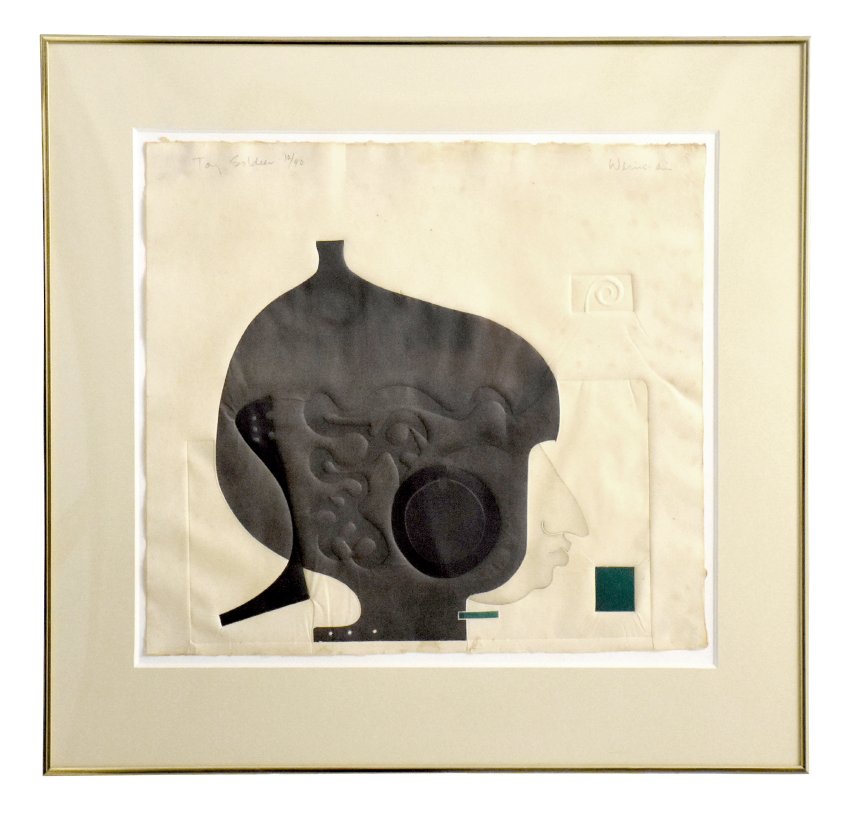Mining For Gold: The Art of Alan Weinstein
Program Overview
This companion program for the online exhibit, Alan Weinstein: The Bruce County Collection 1970-2015, invites secondary students to explore selections of Weinstein’s evocative art from the 1960s and 70s, reflect on their own artistic journeys, and create drypoint prints using accessible recycled materials. The modules highlight the foundational intaglio printmaking technique, inspiring students to explore their creativity and develop their unique artistic voices.
Designed to enrich secondary arts education, the program aligns with the Ontario Visual Arts Curriculum (Grades 9–12), focusing on themes of self-expression, artistic analysis, and hands-on creation.
Curriculum Connections
Visual Arts, Grade 9
Creating and Presenting: A1, A2, A3
Reflecting, Responding, and Analysing: B1, B2.3, B3.1
Foundations: C1.2, C2.1, C2.2, C3.2
Visual Arts, Grade 10
Creating and Presenting: A1, A2, A3
Reflecting, Responding, and Analysing: B1, B2.3, B3.1
Foundations: C1.1, C1.2, C1.3, C2.1, C2.2, C3.2
Visual Arts, AVI3M
Creating and Presenting: A1.1, A1.2, A2.1, A3.1-4
Reflecting, Responding, and Analysing: B1.1 B1.2, B2.3
Foundations: C1, C2.1, C3.2
Visual Arts, AVI3O
Creating and Presenting: A1.1, A1.2, A2.1, A3.2, A3.3
Reflecting, Responding, and Analysing: B1.1 B1.2, B1.4, B2.3, B3.1
Foundations: C1, C2.1, C3.2
Visual Arts, AVI4M
Creating and Presenting: A1.1, A1.2, A2.1, A3.1, A3.2
Reflecting, Responding, and Analysing: B1.1, B1.2, B1.4
Foundations: C1, C2.1, C2.2, C3.2
Visual Arts, AVI4E
Creating and Presenting: A1.1, A1.2, A2.1, A3.1
Reflecting, Responding, and Analysing: B1.1, B1.2;
Foundations: C1, C3.2
Modules
Module 1: Meet the Art & Artist
Take a moment to look closely each piece of art below and discuss:
- What is going on in this image?
- What do you see that makes you say that?
- What more can you find?
(Click on image to view larger)
Fallen Child
1972
Acrylic and chalk on paper
46 x 24 inches
Infanta
1973
Intaglio Print
44 x 21 inches
Toy Solider
1979
Relief Print
24 x 25 inches
Meet the Artist: Alan Weinstein
Born in Toronto in 1939, Alan Weinstein has been given solo exhibitions in museums and galleries in Canada, the United States and Australia since his one-man show in 1961 at the Pollock Gallery in Toronto. He has participated in juried invitational and group shows nationally and internationally. He taught at the Universities of Saskatchewan, Guelph and Texas at San Antonio.
Weinstein’s work is represented in public collections across North America and abroad including museums in Vancouver, Regina, Winnipeg, Toronto, Ottawa, Halifax, Binghamton New York, Eugene Oregon, Austin Texas, Bradford England and Melbourne Australia. His paintings and prints have received honours in the United States and Canada over the last fifty years. He maintains studios in Iowa and Bruce County, Ontario (Teeswater).
Watch below to hear Alan talk about his art education and career.
Think about the following quotes - what do they mean?



Drawing as Core Practice
Journal/Sketch Break:
How do you “plumb your own depths” as an artist? i.e. what is the core of your own creative practice? A medium? A subject? A process?
Works in Series
Alan Weinstein’s works can be grouped into thematic series. He says that he was always impassioned by drawing, though most of his major works in the Bruce County Collection are in other mediums. Below are select works from the 60s and 70s for you to browse. As you do, think about:
- What connects these figure or themes? What changes over time?
- Where do you see line and drawing still playing a role?
(Click on each image to view it fullscreen)
In 1973, “I needed to expand my sense of myself as a drawer by working on glued pieces of paper so I would be working life-size. That sequence led to a series of collage paintings with painted paper that was cut, glued and combined with drawing”.
Three life-size suites of work followed:
Processional, 1973
Weinstein on finding your voice:
Creative Prompt

In your sketchbook/journal, begin to explore what your “gold” (your talents/gifts) might be. Ask yourself:
- Think about what makes you you – your perspective, your gifts, your story, your truth.
- What does your truth feel like?
- What is important to you but that can’t be said with words?
- What shapes, marks, textures, or symbols might represent this?
Start planning a work of art that expresses a part of your “gold” using only line and texture. This will be the foundation of a drypoint print you will make in Module 2 that embodies what you have to share with the world as an artist.
You don’t need to have it all figured out yet. This is your time to reflect, sketch, and begin to imagine what your voice might look like in ink using line and texture.
Module 2: Make the Art
Revisit your prompt: Mining for Gold
Before you begin making your print, return to your reflections from Module 1. Think about this quote from artist Alan Weinstein and ask yourself the following questions:
“Everyone of us has a core, each one of us is a goldmine. The only person who can mine the gold that you have inside of you is you.”
- What idea, emotion, memory, or truth did I start to uncover?
- What makes me me—my perspective, my gifts, my story?
- What symbols, marks, or textures might express that part of me?
Goals for this module:
- Learn how to create a drypoint print using recycled materials
- Use line and texture (not words) to express something from your inner “goldmine”
- Create an original intaglio artwork that reflects your personal voice as an artist
This is your chance to speak through scratch, ink, and imagination—just like Alan Weinstein did. Take your time. Make something that feels like yours.
What is Drypoint?
Drypoint is a type of intaglio printmaking. Artists scratch into a surface called a plate to create lines that will hold ink. The plate is then inked, wiped, and pressed onto paper. Unlike relief printing (like linocut), drypoint is about working into the surface of the plate, not just on it.
Materials
- Recycled clamshell plastic, CD cases, acrylic sheets, old CDs
- Etching tools: blunt craft knives, pushpins, paperclips, nails, embroidery needles, etching styluses, etc.
- Printmaking ink (water-based works best)
- Paper for printing (lightly dampened if possible)
- Small stiff pieces of card for inking
- Tissue, newsprint, or soft cloth
- Spoon for hand-printing
- Optional: Brayer
Creating your Drypoint








What did you discover? You can modify your plate by cleaning and re-etching it, re-inking and printing as you like. Drypoint is about learning how to make mistakes, trying something new, and expressing yourself!
Module 3: Reflect & Share
You’ve explored Alan Weinstein’s art, reflected on his message about self-expression, and created your own drypoint print. Now it’s time to pause, reflect, and share.
Why Reflection Matters
Reflection is part of the creative process. It helps us better understand what we have made and how we have grown—not just as artists, but as thinkers and creators.
As you look at your print, consider the following:
- Did your final print turn out how you expected?
- What surprised or challenged you in the process?
- What strengths or positives can you find in places where the unexpected happened?
- What would you change or try next time?
Think back to Alan Weinstein’s quote: “Talent without passion is like gold in a mine.”
- How did your own artistic “gold” show up in this work?
- In what ways do you feel you expressed your own voice?
Congratulations on completing the Mining For Gold program! To submit student work to be displayed on this site, email Lauren Beer, Education & Outreach Coordinator: Lbeer@brucecounty.on.ca.
Resources
BCM&CC Digital Publication: Alan Weinstein: The Bruce County Collection 1970-2015
Past Perfect Creator Record: Weinstein, Alan
Alan’s Website: Alan Weinstein – Artist | Fine Art – Painting













